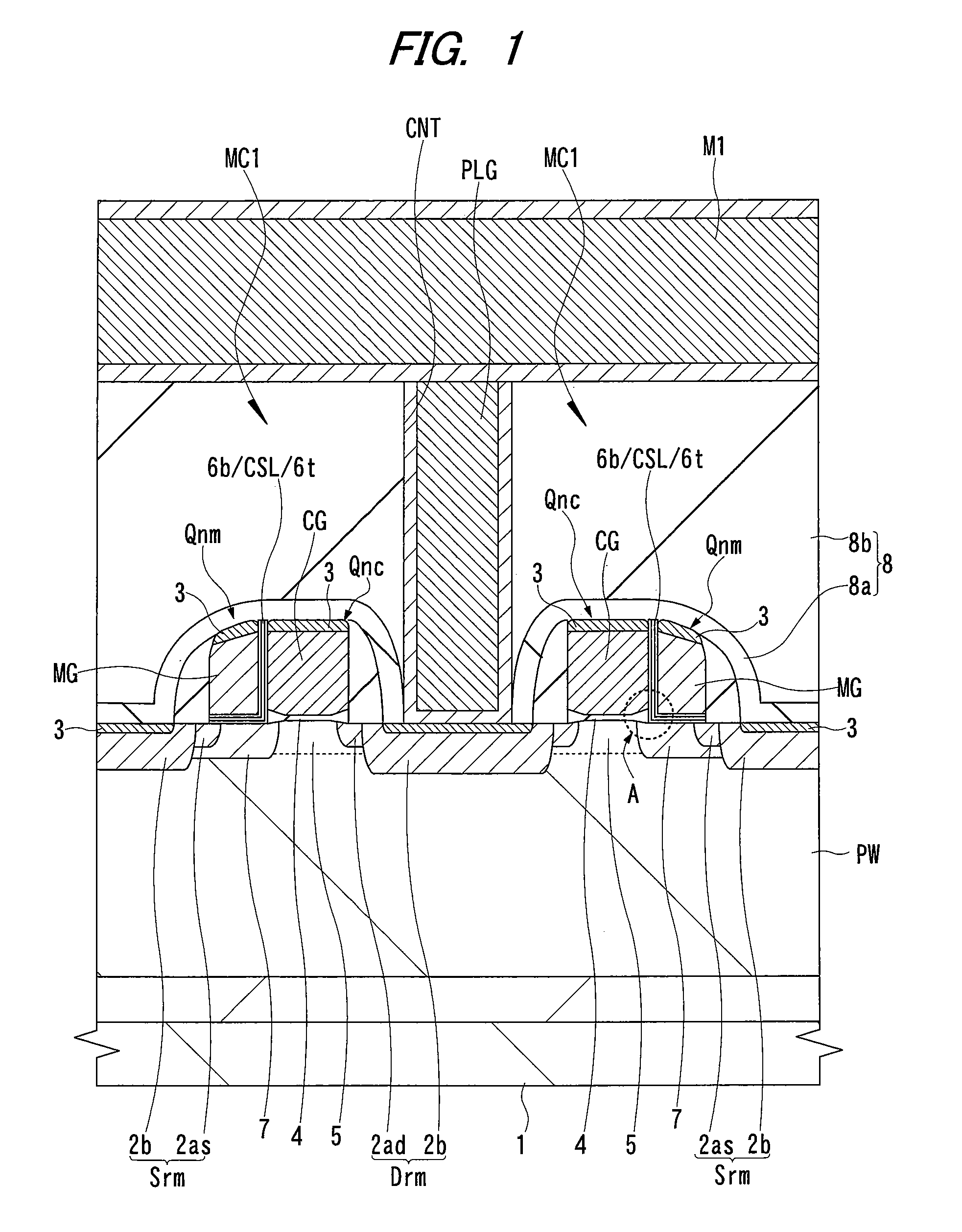Semiconductor memory device and method of manufacturing the same
a memory device and semiconductor technology, applied in the direction of semiconductor devices, basic electric elements, electrical appliances, etc., can solve problems such as program disturbance and become problems
- Summary
- Abstract
- Description
- Claims
- Application Information
AI Technical Summary
Benefits of technology
Problems solved by technology
Method used
Image
Examples
first embodiment
[0058]An example of the structure of a split gate type MONOS memory cell according to a first embodiment of the present invention will be explained with reference to FIGS. 1 and 2. FIG. 1 is a cross sectional view showing the main part of a split gate type MONOS memory cell in which the channel is cut along the direction intersecting to its memory gate electrode, and FIG. 2 is an enlarged cross sectional view of a main part showing the region A of FIG. 1.
[0059]As shown in FIG. 1, a semiconductor substrate 1 is made of, for example, p-type single crystal silicon, a p well PW into which p-type impurities are included is formed. In the active region of the main surface (device formation surface) of the semiconductor substrate 1, an nMIS (Qnc) for selection and an nMIS (Qnm) for memory of a memory cell MC1 according to the first embodiment are arranged. The drain region Drm and the source region Srm of this memory cell MC1 have, for example, n−-type semiconductor regions 2ad and 2as wit...
second embodiment
[0121]In a second embodiment, an example of the method of manufacturing a split gate type MONOS memory cell in which the formation method of the gate dielectric of nMIS for select is different from that in the first embodiment mentioned above will be explained. The method of manufacturing a split gate type MONOS memory cell by the second embodiment will be explained with reference to FIGS. 22 to 24. FIGS. 22 to 24 are cross sectional views showing the main part of a memory cell in the process of manufacture of the semiconductor device. The array structure and the operation conditions of a split gate type MONOS memory cell according to the second embodiment are same as those in the first embodiment mentioned above. Incidentally, because the manufacturing processes except the process of forming the gate dielectric of the nMIS for select is similar to the manufacturing process of the memory cell MC1 of the first embodiment mentioned above, the explanation thereof is omitted herein.
[012...
third embodiment
[0126]In a third embodiment, an example of the method of manufacturing a split gate type MONOS memory cell in which the formation method of the gate dielectric of the nMIS for select is different from that in the first and second embodiments mentioned above will be explained. The method of manufacturing the split gate type MONOS memory cell according to the third embodiment will be explained with reference to FIGS. 25 to 28. FIGS. 25 to 28 are cross sectional views showing the main part of a memory cell in the process of manufacture of the semiconductor device. The array structure and the operation conditions of a split gate type MONOS memory cell according to the third embodiment are same as those in the first embodiment mentioned above. Incidentally, because the manufacturing processes except the process of forming the gate dielectric of the nMIS for select is similar to the manufacturing process of the memory cell MC1 of the first embodiment mentioned above, the explanation there...
PUM
 Login to View More
Login to View More Abstract
Description
Claims
Application Information
 Login to View More
Login to View More - R&D
- Intellectual Property
- Life Sciences
- Materials
- Tech Scout
- Unparalleled Data Quality
- Higher Quality Content
- 60% Fewer Hallucinations
Browse by: Latest US Patents, China's latest patents, Technical Efficacy Thesaurus, Application Domain, Technology Topic, Popular Technical Reports.
© 2025 PatSnap. All rights reserved.Legal|Privacy policy|Modern Slavery Act Transparency Statement|Sitemap|About US| Contact US: help@patsnap.com



